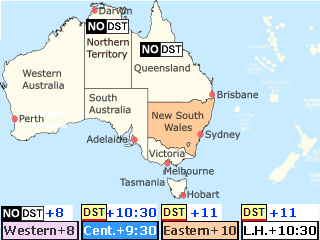2 time zones:
Australia Eastern Time AEST / AEDT ![]() (most)
(most)
UTC +10 ![]() (in winter) UTC +11
(in winter) UTC +11 ![]() (in summer)
(in summer)
Australia Central Time ACST / ACDT ![]()
UTC +9:30 ![]() (in winter) UTC +10:30
(in winter) UTC +10:30 ![]() (in summer) Broken Hill.
(in summer) Broken Hill.
New South Wales is in Australia Eastern time zone
New South Wales uses the time zone +10 hours ahead of Greenwich Mean Time, and +11 hours in daylight saving time, except for Broken Hill wich uses the Central Australia time zone +9:30 hours and +10:30 hours in daylight saving time.
Australia Time Zones (5 time zones) |
|
| Perth - Western Aust. | Eucla - Western Cent. |
| Darwin - North. Terri. | Brisbane - Qld. |
| Adelaide - S. Aust. | Sydney - N.S. Wales |
| Hobart - Tasmania | Melbourne -Victoria |
World Time Map  |
Lord Howe Island |
| GMT = Greenwich Mean Time | |
Oceania - New Zealand |
|
| Auckland, New Zealand | Chatham Islands |
| Australia vs US | US vs Australia |
| Australia vs Canada | Canada vs Australia |
| Australia vs Europe | Europe vs Australia |
| Australia vs China | China vs Australia |
| Australia vs Spain | Spain vs Australia |
| Australia vs US | US vs Australia |
| Australia vs Canada | Canada vs Australia |
| Australia vs Europe | Europe vs Australia |
| Australia vs China | China vs Australia |
| Australia vs Spain | Spain vs Australia |
Australia![]() observe Daylight Saving Time in New South Wales, Victoria, South Australia, Tasmania, the Australian Capital Territory, Lord Howe Island, and Norfolk Island. New Zealand also observes daylight saving time.
observe Daylight Saving Time in New South Wales, Victoria, South Australia, Tasmania, the Australian Capital Territory, Lord Howe Island, and Norfolk Island. New Zealand also observes daylight saving time.
Daylight saving time is not observed in Queensland, the Northern Territory, Western Australia, Christmas Island or the Cocos (Keeling) Islands.
Daylight Saving Time begins at 2:00 am on the first Sunday in October, moving the clock forward one hour, and ends at 3:00 am on the first Sunday in April, moving the clock back one hour.
None of the Central American countries observe DST throughout the year
Chile, and (Easter Island of Chile), and Paraguay. The rest of the countries of South America, do not observe DST throughout the year
| Year | Daylight Saving End (-1h) | Daylight Saving Start (+1h) |
| 2020 | Sunday, 5 April, 03:00 | Sunday, 4 October, 02:00 |
| 2021 | Sunday, 4 April, 03:00 | Sunday, 3 October, 02:00 |
| 2022 | Sunday, 3 April, 03:00 | Sunday, 2 October, 02:00 |
| 2023 | Sunday, 2 April, 03:00 | Sunday, 1 October, 02:00 |
| 2024 | Sunday, 7 April, 03:00 | Sunday, 6 October, 02:00 |
| 2025 | Sunday, 6 April, 03:00 | Sunday, 5 October, 02:00 |
| 2026 | Sunday, 5 April, 03:00 | Sunday, 4 October, 02:00 |
| 2027 | Sunday, 4 April, 03:00 | Sunday, 3 October, 02:00 |
| 2028 | Sunday, 2 April, 03:00 | Sunday, 1 October, 02:00 |
| 2029 | Sunday, 1 April, 03:00 | Sunday, 7 October, 02:00 |
Example

3 Symbols are used to indicate the time zones: Summer, Standard or Winter, and No dst.
The current time zone is shown on the right side of the locality.
![]() Daylight Saving Time or summer time, -except Lord Howe Island- it is 1h. more with respect to the standard o local time zone.
Daylight Saving Time or summer time, -except Lord Howe Island- it is 1h. more with respect to the standard o local time zone.
![]() Winter Time or Standard local time UTC/ GMT, is the one used the rest of the year, when there is no DST summer time.
Winter Time or Standard local time UTC/ GMT, is the one used the rest of the year, when there is no DST summer time.
![]() Do not use daylight saving time throughout the year. (No Daylight Saving Time). The whole year uses the same time zone.
Do not use daylight saving time throughout the year. (No Daylight Saving Time). The whole year uses the same time zone.
The hours +1h. +2h. etc. o -1h. -2h. etc. which appear to the right side of to the Locality, inticate the Current Time Zone of the Locality just at the time of consultation.
For example, if the ![]() symbol appears on the clock and you want to know the local time zone, the (UTC/GMT), you must subtract one hour (except Lord Howe 30 minutes)
symbol appears on the clock and you want to know the local time zone, the (UTC/GMT), you must subtract one hour (except Lord Howe 30 minutes)
The time with the symbol ![]() , as well as the winter symbol, corresponds to the local time or standard UTC/GMT time zone, with the difference that the time zone does not change throughout the year.
, as well as the winter symbol, corresponds to the local time or standard UTC/GMT time zone, with the difference that the time zone does not change throughout the year.
